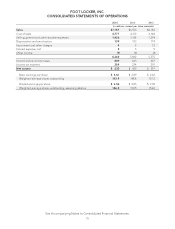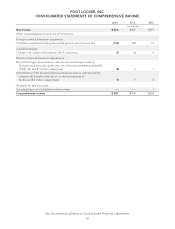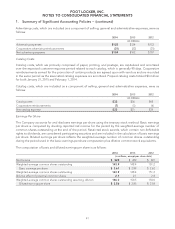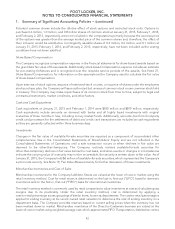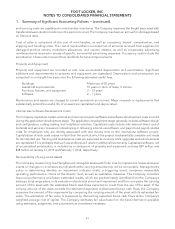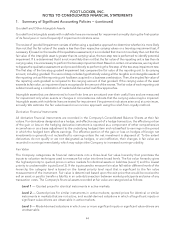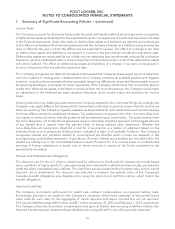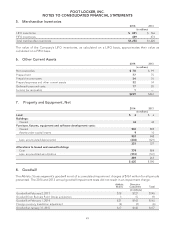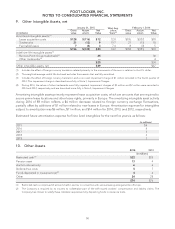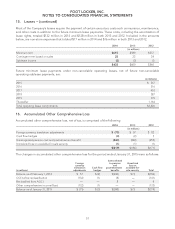Foot Locker 2014 Annual Report Download - page 67
Download and view the complete annual report
Please find page 67 of the 2014 Foot Locker annual report below. You can navigate through the pages in the report by either clicking on the pages listed below, or by using the keyword search tool below to find specific information within the annual report.FOOT LOCKER, INC.
NOTES TO CONSOLIDATED FINANCIAL STATEMENTS
1. Summary of Significant Accounting Policies − (continued)
Goodwill and Other Intangible Assets
Goodwill and intangible assets with indefinite lives are reviewed for impairment annually during the first quarter
of its fiscal year or more frequently if impairment indicators arise.
The review of goodwill impairment consists of either using a qualitative approach to determine whether it is more likely
than not that the fair value of the assets is less than their respective carrying values or a two-step impairment test, if
necessary. If, based on the results of the qualitative assessment, it is concluded that it is not more likely than not that the
fair value of the intangible asset is greater than its carrying value, the two-step test is performed to identify potential
impairment. If it is determined that it is not more likely than not that the fair value of the reporting unit is less than its
carrying value, it is unnecessary to perform the two-step impairment test. Based on certain circumstances, we may elect
to bypass the qualitative assessment and proceed directly to performing the first step of the two-step impairment test.
The first step of the two-step goodwill impairment test compares the fair value of the reporting unit to its carrying
amount, including goodwill. The second step includes hypothetically valuing all the tangible and intangible assets of
the reporting unit as if the reporting unit had been acquired in a business combination. Then, the implied fair value of
the reporting unit’s goodwill is compared to the carrying amount of that goodwill. If the carrying value of the asset
exceeds its fair value, an impairment loss is recognized in the amount of the excess. The fair value of each reporting unit
is determined using a combination of market and discounted cash flow approaches.
Intangible assets that are determined to have finite lives are amortized over their useful lives and are measured
for impairment only when events or changes in circumstances indicate that the carrying value may be impaired.
Intangible assets with indefinite lives are tested for impairment if impairment indicators arise and, at a minimum,
annually. We estimate the fair value based on an income approach using the relief-from-royalty method.
Derivative Financial Instruments
All derivative financial instruments are recorded in the Company’s Consolidated Balance Sheets at their fair
values. For derivatives designated as a hedge, and effective as part of a hedge transaction, the effective portion
of the gain or loss on the hedging derivative instrument is reported as a component of other comprehensive
income/loss or as a basis adjustment to the underlying hedged item and reclassified to earnings in the period
in which the hedged item affects earnings. The effective portion of the gain or loss on hedges of foreign net
investments is generally not reclassified to earnings unless the net investment is disposed of. To the extent
derivatives do not qualify or are not designated as hedges, or are ineffective, their changes in fair value are
recorded in earnings immediately, which may subject the Company to increased earnings volatility.
Fair Value
The Company categorizes its financial instruments into a three-level fair value hierarchy that prioritizes the
inputs to valuation techniques used to measure fair value into three broad levels. The fair value hierarchy gives
the highest priority to quoted prices in active markets for identical assets or liabilities (Level 1) and the lowest
priority to unobservable inputs (Level 3). If the inputs used to measure fair value fall within different levels of the
hierarchy, the category level is based on the lowest priority level input that is significant to the fair value
measurement of the instrument. Fair value is determined based upon the exit price that would be received to
sell an asset or paid to transfer a liability in an orderly transaction between market participants exclusive of any
transaction costs. The Company’s financial assets recorded at fair value are categorized as follows:
Level 1 — Quoted prices for identical instruments in active markets.
Level 2 — Quoted prices for similar instruments in active markets; quoted prices for identical or similar
instruments in markets that are not active; and model-derived valuations in which all significant inputs or
significant value-drivers are observable in active markets.
Level 3 — Model-derived valuations in which one or more significant inputs or significant value-drivers are
unobservable.
44



